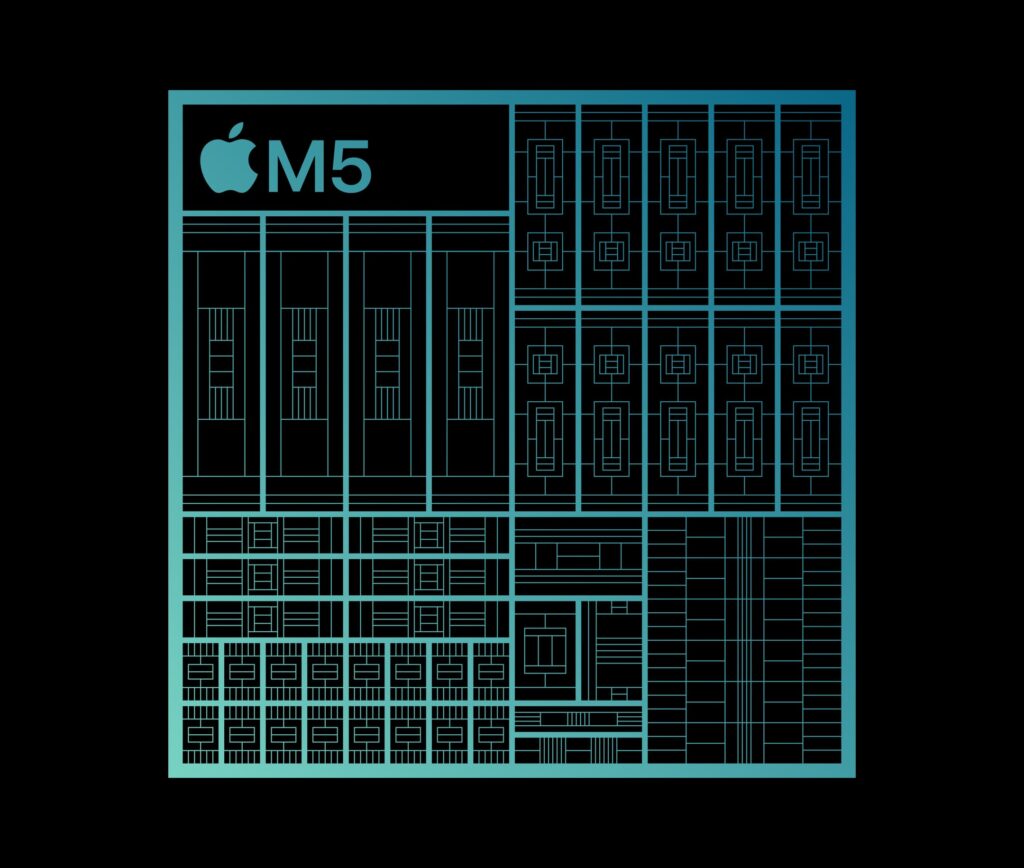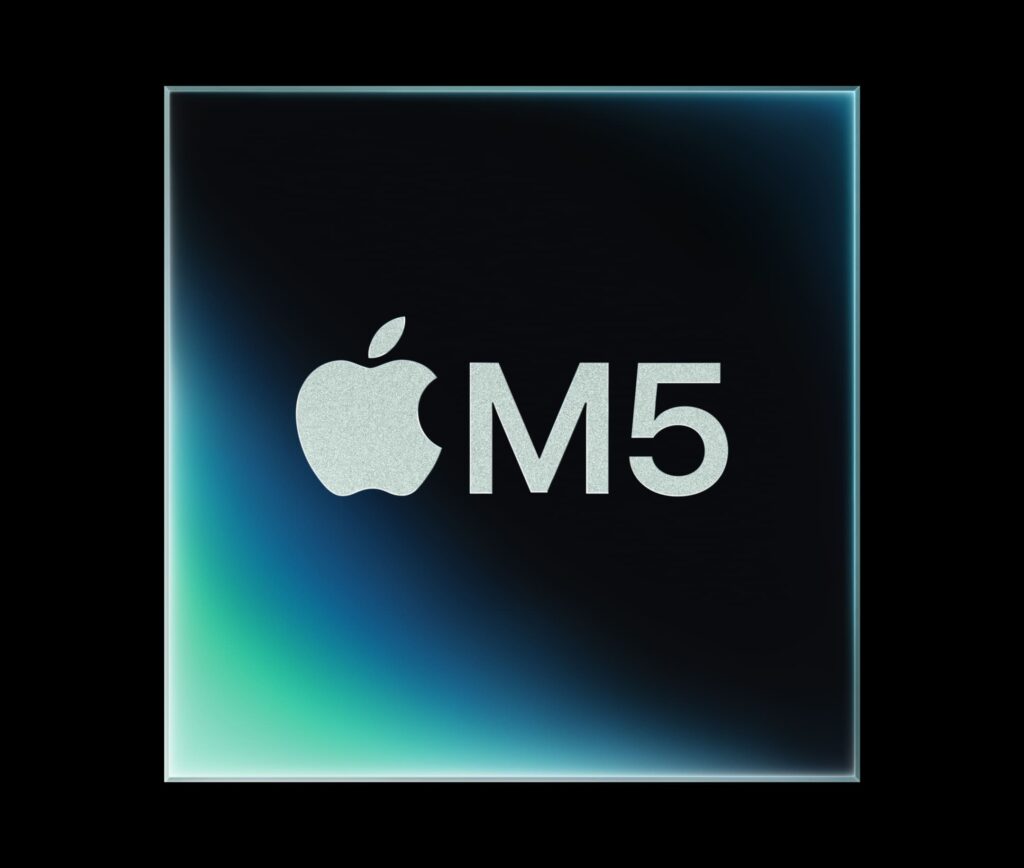Apple announced today M5, its new System on a Chip (SoC) for computers and mixed reality devices, with a clear focus: to bring more AI performance directly to the device, reducing reliance on the cloud. The company confirms that the M5 debuts in the new 14-inch MacBook Pro, the iPad Pro, and Apple Vision Pro, all available for pre-order starting today, October 15, 2025.
The M5 is built with third-generation 3nm technology and introduces a 10-core graphics architecture featuring a Neural Accelerator in each GPU core. With this approach, Apple guarantees more than 4× GPU computing increase for AI workloads compared to M4, along with an uplift of up to 45% in graphics performance in ray-traced applications. The chip also includes a CPU with up to 10 cores (four performance cores and six efficiency cores), a 16-core Neural Engine for faster AI processing, and a unified memory bandwidth of 153 GB/s, nearly 30% higher than M4.
A redesigned GPU for the AI era
The main innovation of the M5 is its “AI-accelerated” GPU, where each graphics core includes a dedicated Neural Accelerator. In practice, this allows much faster execution of tasks like diffusion-based image generation, AI video masking, or local execution of large language models (LLMs) in tools like LM Studio, all on the device. Apple estimates a up to 30% improvement in graphics performance compared to M4 and up to 2.5× compared to M1, adding second-generation dynamic cache to better allocate GPU resources, with direct benefits for gaming and 3D rendering.
The third-generation ray tracing arrives across the lineup with M5, enhancing light, shadow, and reflection fidelity. In the case of Apple Vision Pro, this translates into 10% more pixels rendered on the micro-OLEDs and refresh rates up to 120 Hz, with less motion blur and a smoother experience on the virtual Mac screen.
CPU and Neural Engine: increased responsiveness and computing autonomy
Apple again touts having the “world’s fastest performance cores” within a configuration of up to 10 cores in the CPU. This setup delivers up to 15% more multi-threaded performance compared to M4, with specific improvements for code compilation, video editing, or mixed productivity workloads. The 16-core Neural Engine also accelerates Apple Intelligence functions and third-party apps, benefiting from the increased memory bandwidth of the unified memory.

Unified memory remains a key feature in Apple’s offerings. With 153 GB/s bandwidth, the M5 can load larger AI models entirely locally, avoiding the latency of cloud processing and seamless data sharing across CPU, GPU, and NPU pools. Apple emphasizes that this architecture supports demanding workflows—for example, editing in Final Cut Pro while uploading large files—and mentions configurations with up to 32 GB of memory capacity in M5-powered systems.
First devices with M5
14-inch MacBook Pro
The new 14″ MacBook Pro with M5 delivers up to 1.6× the graphics performance in professional apps and up to 1.6× higher frame rates in games compared to the M4 version. In CPU tasks, Apple reports up to 20% more multi-threaded performance for tasks like compiling in Xcode, and maintains its signature: up to 24 hours of battery life per tests. It surpasses 150 GB/s of memory bandwidth and arrives with macOS Tahoe and integrated Apple Intelligence. Pre-orders begin today, with retail availability starting Wednesday, October 22.
iPad Pro with M5
On tablet, the move to M5 results in up to 3.5× more AI performance compared to the M4 iPad Pro and up to 5.6× over M1. The new generation incorporates the N1 wireless chip, supporting Wi-Fi 7, Bluetooth 6, and Thread, and models with cellular connectivity feature the C1X modem, promising up to 50% faster cellular data with lower power consumption. Memory bandwidth exceeds 150 GB/s, and storage read/write speeds are doubled. iPadOS 26 introduces a new windowing system, and the device can charge to 50% in about 30 minutes using the 40 W (max 60 W) USB-C charger. The 256 GB and 512 GB models now start with 12 GB of unified memory. Pre-orders start today, shipping on October 22.
Apple Vision Pro (second generation) with M5
The Apple spatial computing headset is also updated. With M5, Vision Pro features 10% more pixels, increases refresh rates up to 120 Hz, accelerates AI functions like Personas and transforming photos into spatial scenes, and extends battery life to 2.5 hours of general use (and 3 hours of video). Additionally, it debuts the Dual Knit Band, a dual-padded strap with a dial for better fit. Pre-orders open today in initial markets with general availability also on October 22.
Apple Intelligence and language support
Apple Intelligence, the company’s embedded AI features, is available in beta and already supports Spanish, in addition to English, French, German, Italian, Portuguese (Brazil), Simplified Chinese, Japanese, and Korean. Not all features will arrive simultaneously across all languages or regions; Apple maintains a page detailing the requirements and availability.
Market impact: More on-device AI and competitive pressure
Apart from the numbers, this move reinforces Apple’s strategy to bring AI to the edge—directly on the user’s hardware—with improvements in both performance and energy efficiency. It also keeps prices unchanged in the U.S. for today’s products (MacBook Pro, iPad Pro, and new Vision Pro), applying pressure on competitors pushing AI-centric processors like Qualcomm and Intel.
Developers and creators: APIs and frameworks ready for M5
The software ecosystem gains momentum. Applications already utilizing Core ML, Metal Performance Shaders, and Metal 4 automatically benefit from the new hardware. Additionally, Apple opens the door for direct programming of the Neural Accelerators via Tensor APIs in Metal 4, promising even faster AI-specific workloads. For creative and professional use, Apple highlights apps like Draw Things, DaVinci Resolve, Octane X, and Topaz Video as early adopters of the new compute blocks.
Sustainability and efficiency
In its environmental roadmap, Apple reaffirms its Apple 2030 plan to be carbon neutral by the end of the decade. The increased energy efficiency of the M5 helps reduce energy consumption over the device’s lifespan—a point the company emphasizes alongside its commitment to renewable energy in the supply chain and the use of 100% recycled fiber packaging in products like the MacBook Pro.
Key dates and availability
- Pre-order: starting today, October 15, 2025 (MacBook Pro 14″, iPad Pro, and Vision Pro).
- In-store availability: Wednesday, October 22, 2025, with variations by country. Apple details markets and dates in each product note (for example, Vision Pro mentions phased regional rollouts).
Frequently Asked Questions
What are the actual improvements of M5 over M4 and M1?
M5 offers over 4× peak GPU compute for AI workloads compared to M4, up to 30% more overall graphics performance (and 45% with ray tracing), a CPU with up to 10 cores providing up to 15% higher multi-threaded performance, and a 16-core Neural Engine that is faster. It also increases the unified memory bandwidth to 153 GB/s. Against M1, graphics improvements with M5 reach 2.5×.
Can M5 run large AI models offline?
Yes. The unified memory architecture (CPU, GPU, and NPU sharing one pool) and bandwidth of 153 GB/s enable loading and executing larger models entirely on the device. Apple claims that with configurations up to 32 GB of memory, heavy creative suites can run while AI tasks are processed in the background. Actual performance depends on model size, optimization, and application used.
What connectivity improvements does the M5 iPad Pro offer?
The iPad Pro integrates the new N1 chip with Wi-Fi 7, Bluetooth 6, and Thread, and cellular models feature the C1X modem, offering up to 50% faster data speeds with lower power consumption. It also improves memory bandwidth and doubles storage read/write speeds for professional workflows.
When will the first M5 products arrive, and what battery life is expected?
Pre-orders start today, with general availability on October 22, 2025. Apple indicates up to 24 hours of battery life on the MacBook Pro 14″, and for Vision Pro, up to 2.5 hours of general use and 3 hours of video playback with the included external battery.
Note: Apple Intelligence is in beta, and its availability by language and region varies; Spanish is among the supported languages. Consult official requirements for details by country and feature.

